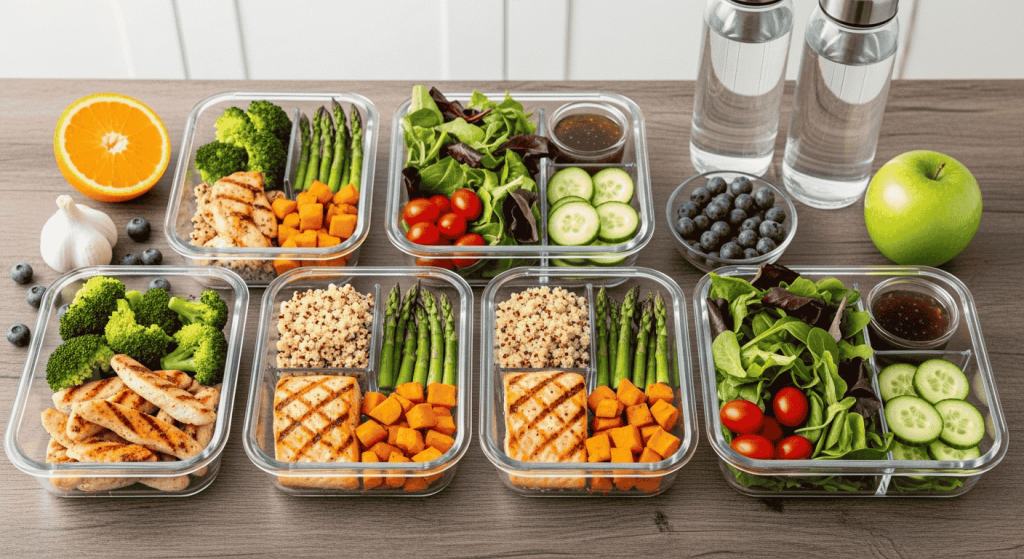The plant-based and clean eating movement has reached unprecedented momentum in 2025, with millions embracing whole foods nutrition for optimal health and environmental sustainability. This comprehensive guide explores how plant-based clean eating can transform your wellness journey while aligning with current food trends focused on healthful, minimally processed foods.
Understanding Plant-Based Clean Eating Fundamentals
Plant-based clean eating combines the principles of consuming predominantly plant foods with choosing minimally processed, whole food ingredients. This approach focuses on vegetables, fruits, whole grains, pulses (beans, lentils, and peas), nuts, seeds, and high-quality plant proteins in their less processed states.
Ultimate Guide to Rome’s Historical Sites
Core Principles of Clean Eating:
- Emphasize whole, unprocessed foods
- Minimize refined sugars and artificial additives
- Choose organic options when possible
- Read ingredient labels carefully
- Prepare meals from scratch using fresh ingredients
- Focus on nutrient-dense plant foods
Benefits of Plant-Based Nutrition:
- Weight Management: Studies show eating minimally processed meals can double weight loss results
- Disease Prevention: Reducing processed meat consumption by 30% could significantly reduce rates of type 2 diabetes, heart disease, and colon cancer
- Environmental Impact: Lower carbon footprint compared to animal-based diets
- Digestive Health: Higher fiber content supports gut microbiome
- Energy Levels: Stable blood sugar from complex carbohydrates
Immune-Boosting Nutrition Trends
Essential Plant-Based Clean Eating Foods for 2025
Trending Superfoods and Plant Proteins
Current nutrition trends highlight fermented foods, berries, leafy greens, and legumes as top superfoods for 2025, with beans, peas, and lentils recognized as essential plant-based protein sources.
Top Plant-Based Protein Sources:
- Legumes: Black beans, chickpeas, lentils, and split peas
- Quinoa: Complete protein with all essential amino acids
- Hemp Seeds: Rich in omega-3 fatty acids and minerals
- Chia Seeds: High in protein, fiber, and antioxidants
- Tempeh: Fermented soy with probiotics
- Nuts and Nut Butters: Almonds, cashews, and tahini
Whole Foods Categories for Clean Eating
Fresh Produce:
- Dark leafy greens (kale, spinach, arugula)
- Colorful vegetables (bell peppers, carrots, beets)
- Seasonal fruits (berries, citrus, stone fruits)
- Cruciferous vegetables (broccoli, cauliflower, Brussels sprouts)
Wearable Health Trackers for Daily Wellness
Whole Grains:
- Brown rice and wild rice
- Quinoa and amaranth
- Steel-cut oats
- Buckwheat and millet
- Whole grain pasta and bread
Healthy Fats:
- Avocados
- Raw nuts and seeds
- Cold-pressed olive oil
- Coconut oil (in moderation)
- Flaxseeds and chia seeds
Building Your Plant-Based Clean Eating Meal Plan
Daily Nutrition Framework
Creating a balanced plant-based clean eating routine requires strategic meal planning to ensure adequate nutrition while avoiding processed foods.
Gut Health and Probiotics Explained
Breakfast Foundation:
- Overnight oats with berries and hemp seeds
- Green smoothie with leafy greens, banana, and plant protein
- Avocado toast on sourdough with nutritional yeast
- Chia pudding with coconut milk and fresh fruit
Lunch Ideas:
- Buddha bowls with quinoa, roasted vegetables, and tahini dressing
- Large salads with mixed greens, beans, and homemade vinaigrette
- Soup and whole grain bread combinations
- Veggie-packed wraps with hummus and sprouts
Dinner Options:
- Minimally processed dinner recipes featuring vegetables, whole grains, and plant proteins
- Stir-fries with brown rice and seasonal vegetables
- Bean-based pasta dishes with fresh herbs
- Roasted vegetable medleys with quinoa
How Drinking Enough Water Can Transform Your Health
Weekly Meal Prep Strategies
Batch Cooking Essentials:
- Cook large batches of grains and legumes
- Prepare chopped vegetables for easy assembly
- Make homemade dressings and sauces
- Prep mason jar salads for grab-and-go meals
- Prepare energy balls and healthy snacks
Smart Shopping Tips:
- Shop the perimeter of the grocery store first
- Visit farmers markets for seasonal produce
- Buy organic for the “Dirty Dozen” items
- Purchase grains and legumes in bulk
- Read ingredient lists carefully
Navigating Challenges in Plant-Based Clean Eating
Common Nutritional Considerations
Ensuring Adequate Protein: Combine different plant proteins throughout the day to obtain complete amino acid profiles. Focus on variety rather than perfection at each meal.
How to Eat Healthy While Traveling in Europe
Key Nutrients to Monitor:
- Vitamin B12: Consider supplementation or fortified foods
- Iron: Pair iron-rich foods with vitamin C sources
- Omega-3 Fatty Acids: Include walnuts, flaxseeds, and algae-based supplements
- Vitamin D: Monitor levels and supplement if necessary
- Calcium: Include fortified plant milks, leafy greens, and tahini
Overcoming Social and Practical Obstacles
Restaurant Dining:
- Research menus in advance
- Ask about preparation methods
- Request modifications when needed
- Focus on naturally plant-based cuisines
Family and Social Settings:
- Bring plant-based dishes to share
- Educate with enthusiasm, not judgment
- Focus on how great you feel
- Find plant-based community support
Why Fiber is the Secret to a Healthy Gut
Advanced Clean Eating Strategies
Fermented Foods and Gut Health
Fermented foods like yogurt, kimchi, and kombucha rank as top superfoods for 2025, supporting gut health and overall wellness.
Plant-Based Fermented Options:
- Sauerkraut and kimchi
- Kombucha and water kefir
- Miso and tempeh
- Coconut yogurt with live cultures
- Fermented vegetables
Seasonal Eating Approach
Align your plant-based clean eating with seasonal availability to maximize nutrition, flavor, and environmental benefits.
Spring: Asparagus, peas, leafy greens, and fresh herbs Summer: Berries, stone fruits, tomatoes, and zucchini Fall: Squash, apples, root vegetables, and cruciferous vegetables Winter: Citrus fruits, stored grains, beans, and preserved foods
Creating Sustainable Habits
The 80/20 Principle
Aim for 80% plant-based clean eating while allowing 20% flexibility for social situations and personal preferences. This approach promotes long-term sustainability over perfectionism.
Healthy Snacks for Weight Loss You Can Make at Home
Gradual Transition Strategies
Week 1-2: Replace processed snacks with whole fruits and nuts Week 3-4: Introduce plant-based proteins at one meal daily Week 5-6: Increase vegetable portions and decrease processed foods Week 7-8: Focus on whole grain swaps and homemade meals
Building Your Support System
Connect with like-minded individuals through online communities, local meetups, and cooking classes. Share recipes, challenges, and victories to maintain motivation and accountability.
FAQ: Plant-Based Clean Eating Lifestyle
What exactly defines clean eating in a plant-based diet?
Plant-based clean eating focuses on consuming whole, minimally processed plant foods in their natural state. This includes fruits, vegetables, nuts, seeds, beans, lentils, and whole grains while avoiding processed foods with added sugars, salt, fats, or artificial additives. The emphasis is on ingredients you can pronounce and foods that don’t require extensive ingredient lists.
How do I ensure adequate protein on a plant-based clean eating plan?
Beans, peas, and lentils serve as essential plant-based protein sources with lower saturated fat content than animal proteins, while being rich in fiber for improved health outcomes. Include a variety of protein sources throughout your day: quinoa, hemp seeds, nuts, tempeh, and legumes. Combining different plant proteins naturally provides complete amino acid profiles.
Can plant-based clean eating help with weight management?
Research demonstrates that eating minimally processed meals can double weight loss results compared to diets including ultra-processed foods, even when those processed options are considered healthy. Plant-based clean eating naturally increases fiber intake, improves satiety, and reduces calorie density while providing essential nutrients for sustainable weight management.
What are the biggest challenges when starting plant-based clean eating?
Common challenges include meal planning, social dining situations, and ensuring nutritional adequacy. Start gradually by replacing one meal per day with plant-based options, batch cook staples like grains and beans, and focus on learning new cooking techniques. Address potential nutrient gaps like B12, iron, and omega-3s through strategic food choices and appropriate supplementation.
The Truth About Sugar: How Much is Too Much?
How expensive is maintaining a plant-based clean eating lifestyle?
Plant-based clean eating can be very budget-friendly when focused on whole foods like beans, grains, seasonal produce, and bulk purchases. Preparing minimally processed meals at home using unprocessed ingredients typically costs less than purchasing processed convenience foods or eating out regularly. Invest in good storage containers and basic kitchen tools to maximize your investment.
Transform Your Health with Plant-Based Clean Eating
Embracing a plant-based clean eating lifestyle offers profound benefits for your health, the environment, and your overall quality of life. By focusing on whole foods nutrition and minimally processed ingredients, you create a sustainable foundation for long-term wellness.
Remember, this journey is about progress, not perfection. Start with small, manageable changes and gradually build your plant-based clean eating habits. Every meal is an opportunity to nourish your body with wholesome, unprocessed foods that support your health goals.
Healthy Desserts & Snacks to Satisfy Your Cravings
Ready to transform your kitchen and health? Discover premium plant-based ingredients, meal planning tools, and clean eating resources to support your wellness journey.
to explore curated products that make plant-based clean eating simple, delicious, and sustainable.











